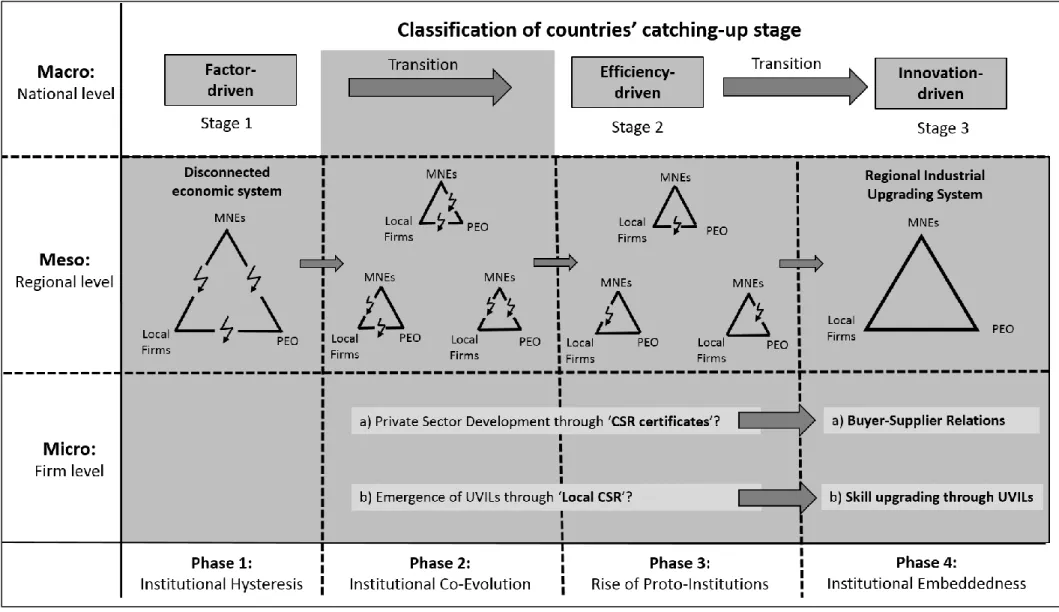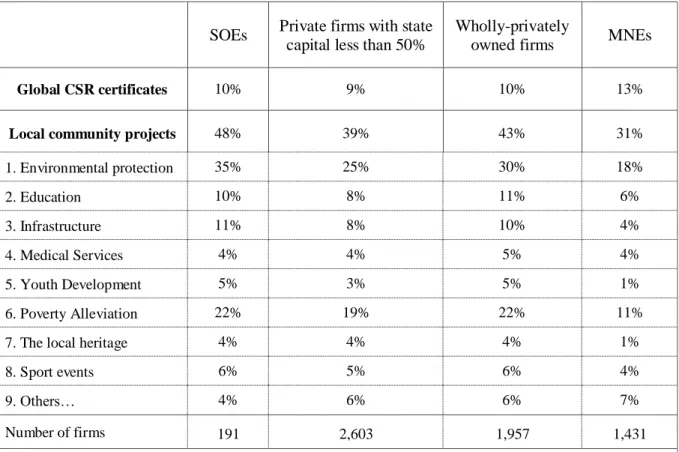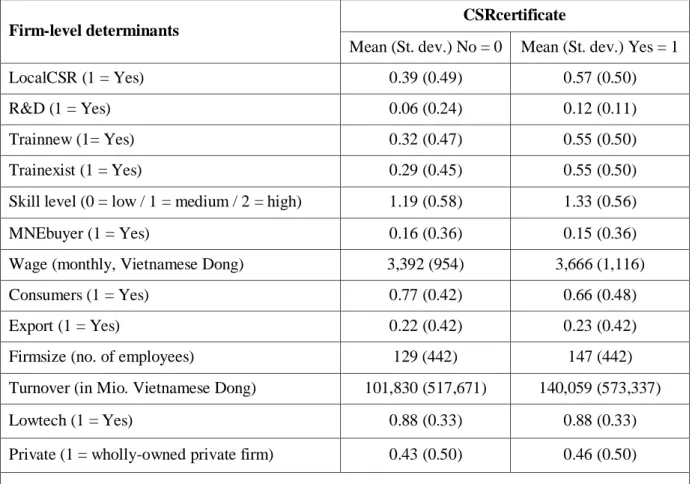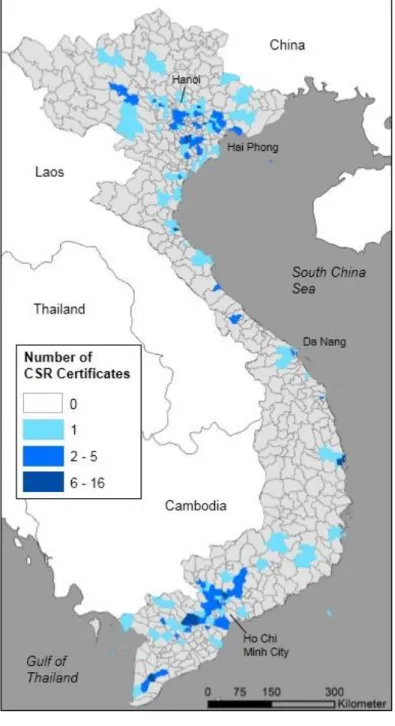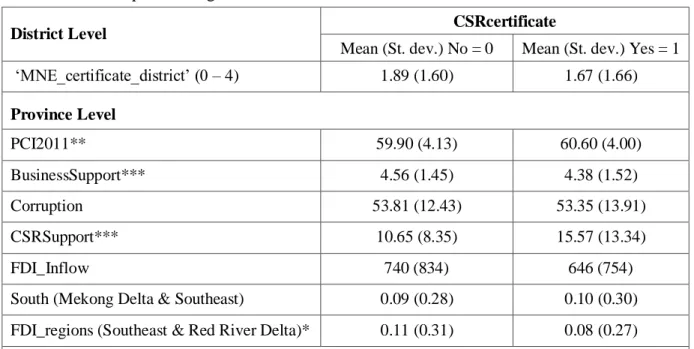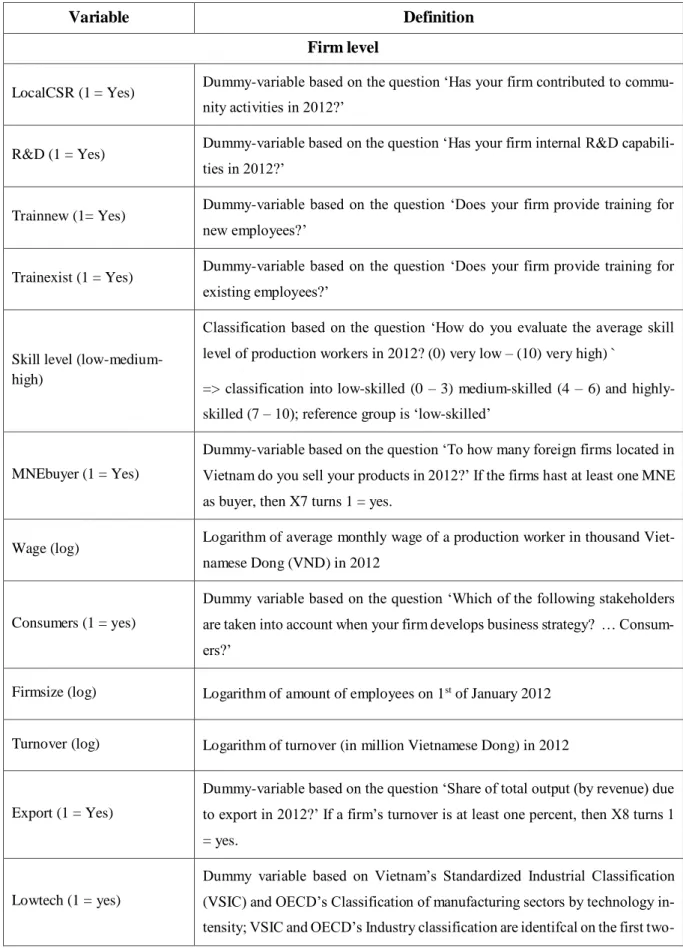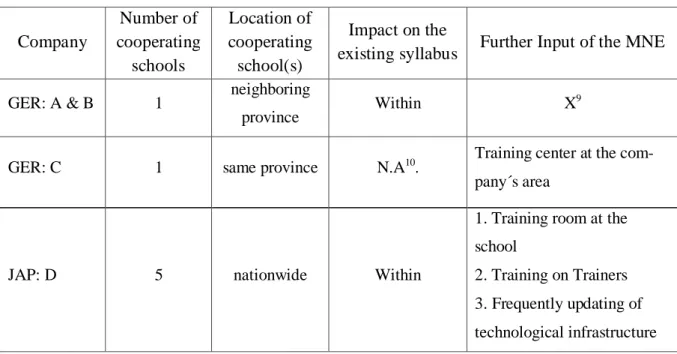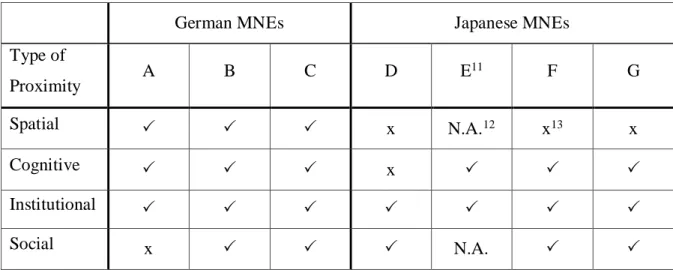Dipl.-Geogr. Jöran Wrana
Multinational Enterprises, Corporate Social Responsibility, and Regional Institutional Change in Vietnam
Multinational Enterprises, Corporate Social Responsibility, and Regional Institutional Change in Vietnam
Inaugural-Dissertation
zur
Erlangung des Doktorgrades
der Mathematisch-Naturwissenschaftlichen Fakultät der Universität zu Köln
vorgelegt von
Dipl.-Geogr. Jöran Bosse Wrana aus Neumünster
Köln, 2017
Berichterstatter:
Prof. Dr. Javier Revilla Diez (Universität zu Köln) Prof. Dr. Daniel Schiller (Universität Greifswald) Tag der mündlichen Prüfung: 09.11.2017
I
Acknowledgements
First of all, I would like to express my deepest thanks to Professor Dr. Javier Revilla Diez who has supported me from the very beginning of my academic career as a diploma student at the Institute of Economic and Cultural Geography in Hannover until the end of this PhD project at the University of Cologne. In particular, I appreciate his expertise and critical feedback which were a key pillar for the development of my papers in the context of this PhD and the freedom he gave me which allowed me to think in new ways how to contribute to existing economic geography literature. I am also grateful to Dr. Amelie Bernzen who made a great job as my second supervisor under the umbrella of the Geoscience Graduate School.
Furthermore, I would like to thank the German Research Foundation, the Geoscience Graduate School at the University of Cologne and the German Academic Exchange Service for financing my research trips to Vietnam, my visits to international conferences, the purchase of empirical data and all other related cost issues which accompany such a PhD project.
I would like to express special thanks to my colleagues Thomas Neise, Xuan Thu Nguyen, Franziska Sohns and Moritz Breul for receiving their valuable feedback in discussions on my papers and for having great time at GSSC public lecturers (and afterwards), on conferences and on the legendary wall in front of our Institute. I am also deeply grateful to Hung Do Trong, Bui Thu Ha, Mai Do Le, Le Viet Thai, Hoang Linh Dang, Florian Deichmann, the 35 students from the Diplomatic Academy of Vietnam who participated in the phone survey during my first re- search trip and to all my interview partners. Without their great support during my data -gather- ing trips in Vietnam, it would have been impossible to bring this dissertation project to a suc- cessful end.
Words of thanks also go to Professor Dr. Daniel Schiller as my second reviewer of this disser- tation, Prof. Dr. Peter Dannenberg, Jana Moneke, Lena Krist, Lara Gaab, Fabio Pruss, Clara Wuest, Susanne Weber, all other colleagues from the Institute of Geography in Cologne, Milad Abbasiharofteh and Frank Weber.
Finally, I would like to thank all my friends in Cologne, Hannover and Vietnam for all their comforting words, prayers and help which pushed me to go on with my PhD project. I dedicate this PhD-thesis to my family Heike Wrana, Thomas Wrana, Magali Wrana, Rita Runge, Manfred Runge and Ernst Wrana who have always believed in me.
II
Table of contents
Acknowledgements ... I List of figures ...V List of tables ... VI List of abbreviations and acronyms ... VII
1. Introduction ... 1
1.1 Multinational enterprises in a globalized world – a brief overview ... 1
1.2 Multinational enterprises in the global South – an institutional perspective ... 3
1.3 Research objectives and outline of the papers ... 8
2. Multinationals, CSR and regional industrial change in transition economies ... 11
2.1 Introduction ... 12
2.2 Economic development in Emerging Economies – an IB Perspective ... 14
2.2.1 MNEs and Industrial Upgrading in Emerging Economies ... 14
2.2.2 MNEs, CSR and Development in Emerging Economies... 15
2.3 Economic development in emerging economies – a Geographical Perspective ... 16
2.3.1 Institutions, Institutional Change and Regional Economic Development ... 16
2.3.2 University-Industry linkages and Regional Economic Development ... 18
2.4 The CSR─RIU-Model ... 18
2.4.1 Global CSR Certificates and Regional Institutional Change... 21
2.4.2 The formation of UVILs: Institutional Entrepreneurship through Local CSR ... 22
2.5 Conclusion and Outlook ... 24
2.6 References ... 25
3. Research Design ... 32
3.1 Vietnam’s development since Doi Moi ... 33
3.2 Vietnam’s current challenges and the relevance of CSR ... 36
3.3 Data & Methodology ... 41
3.3.1 Quantitative empirical approaches ... 42
3.3.2 Qualitative empirical approaches ... 44
III
domestic firms in a transition economy ─ Evidence from Vietnam ... 49
4.1 Introduction ... 50
4.2 Conceptual framework ... 52
4.3 Data and methods ... 54
4.3.1 Dependent variables ... 55
4.3.2 Independent variables at firm, district and province level ... 56
4.3.3 Methodological approach... 58
4.4 Results ... 60
4.5 Discussion ... 71
4.6 Conclusion... 73
4.7 References ... 74
4.8 Appendix ... 80
5. Can Multinational Enterprises Introduce new Institutions to Host Countries? - An explorative study about MNEs’ training programs with educational institutes and their potential influence on Vietnam’s vocational education sector ... 82
5.1 Introduction ... 84
5.2 Conceptual framework ... 85
5.2.1 Skill Formation Systems and the Vietnamese case ... 86
5.2.2 Impact of MNEs on Vietnam’s vocational education sector ... 88
5.2.3 The role of proximity for finding vocational colleges as suitable cooperation partners ... 90
5.3 Data and Methodology ... 92
5.4 Results ... 93
5.4.1 Overview about MNEs and dual training programs in Vietnam ... 93
5.4.2 Institutional Entrepreneurship in Vietnam’s vocational training systems ... 95
5.4.3 The role of proximity for MNEs in finding local schools as collaboration partners ... 99
5.5 Discussion and Limitation of the results ... 102
5.6 Conclusion and potential for future research ... 105
IV
5.8 Acknowledgements ... 112
6. Why do new institutions not arise in Vietnam’s Red River Delta? – The neglected role of varying embeddedness between local firms and multinational enterprises ... 114
6.1 Introduction ... 115
6.2 Theoretical framework ... 116
6.2.1 Institutionalization of organizational practices in host regions ... 117
6.2.2 The role of embeddedness for the diffusion of institutions in host regions... 118
6.3 The Vietnamese context and the Red River Delta as a case study ... 121
6.4 Empirical Approach ... 123
6.5 The diffusion of new organizational practices into the RRD... 126
6.6 Embeddedness and the diffusion of organizational practices into the RRD ... 129
6.7 Discussion ... 131
6.8 Conclusion... 132
6.9 References ... 134
7. Concluding Discussion ... 139
7.1 Theoretical contributions... 140
7.2 Empirical evidence ... 145
7.3 Policy Implications ... 149
7.4 Limitations and recommendations for future research ... 154
8. References for chapter 1, 3, and 7 ... 158
Summary ... 177
Zusammenfassung... 179
Appendix A Guiding questions for interviews with MNEs ... 181
Appendix B Guiding questions for interviews with local firms ... 186
Appendix C Own contributions made to publications in chapters 2, 4, 5 and 6 ... 191
Appendix D Eigenständigkeitserklärung ... 192
V
List of figures
Fig. 2.1 The Corporate Social Responsibility ─ Regional Industrial Upgrading (CSR─RIU)
Model ... 19
Fig. 4.1 Empirical framework ... 55
Fig. 4.2 No. of MNEs with CSR certificates on district level... 62
Fig. 4.3 No. of local firms with CSR certificates on district level... 62
Fig. 5.1 Types of skill formation systems ... 86
Fig. 5.2 Type & Extent of MNEs` joint training programs with Vietnamese schools ... 95
Fig. 5.3 The role of proximity for MNEs to find local schools as cooperation partners ... 99
Fig. 6.1 Location of interviewed Vietnamese firms in RRD ... 124
VI
List of tables
Table 1.1 Guiding research questions for this dissertation ... 9
Table 3.1 Type and extent of CSR practices by firm ownership type in 2012 ... 39
Table 4.1 Description of firm capabilities and CSR certificates ... 60
Table 4.2 Description of regional factors and CSR Certificates ... 63
Table 4.3 Effect of having a CSR certificate on productivity growth (13-14) ... 64
Table 4.4 Relevance of the regional level for a firms’ adoption of CSR certificates ... 64
Table 4.5 Results of the multilevel models (Dependent variable: CSRcertificate) ... 65
Table 4.6 Robustness test (Dependent variable: CSRcertificate)... 69
Table 4.A1 Detailed description of selected variables ... 80
Table 6.1 Human resource development in Vietnam’s main economic centers ... 122
Table 6.2 Overview of interviewed firms in the Red River Delta ... 125
Table 6.3 Overview of diffusion of new institutions among Vietnamese firms in RRD... 127
VII
List of abbreviations and acronyms
AHK Außenhandelskammer (German Chambers of Commerce)
ASEAN Association of Southeast Asian Nations ATT Average Treatment effect on the Treated CIEM Central Institute of Economic Management
CSR Corporate Social Responsibility
CSR─RIU Corporate Social Responsibility – Regional Industrial Upgrading DAAD Deutscher Akademischer Austauschdienst (German Academic
Exchange Service)
DAV Diplomatic Academy of Vietnam
DFG Deutsche Forschungsgemeinschaft (German Research Founda- tion)
e.g. for example (exempli gratia)
EPV events per predictive variable
FDI Foreign Direct Investment
GDVT General Department of Vocational Training
GIZ / GTZ Gesellschaft für internationale / technische Zusammenarbeit
GSO General Statistics Office
HCMC Ho Chi Minh City
JICA Japan International Cooperation Agency
IB International Business
ICC Intra-class correlation coefficient
ISO International Standard Organization
IV Instrumental variable
Local firms private domestic firms / private Vietnamese firms
MNE Multinational Enterprise
MOET Ministry of Education and Training
MoLISA Ministry of Labour, Invalids and Social Affairs
NGO Non-governmental Organizations
NIE New Institutional Economics
OECD Organization for Economic Cooperation and Development
OFJ Off-the-job (training)
OTJ On-the-job (training)
VIII
PEO Public educational organizations
PhD Doctor of Philosophy / philosophiae doctor
PR Policy Recommendation
PSM Propensity Score Matching
pwc pricewaterhousecoopers
RIUS Regional industrial upgrading system
RQ Research Question
RRD Red River Delta
R&D Research and development
SFS Skill formation system
SME small- and medium-sized enterprises
SOE State-owned enterprise
STCs Short-term courses
TCS Technology and Competitiveness Survey
TFP Total Factor Productivity
TTIP Transatlantic Trade and Investment Partnership TVET Technical vocational education and training
UoC University of Copenhagen
USAID United States Agency for International Development
USD United States Dollar
UIL University-Industry Linkages
U.N. United Nations
UNCTAD United Nations Conference on Trade and Development UNIDO United Nations Industrial Development Organization UVIL University-Vocational-College-Industry Linkages VCCI Vietnamese Chambers of Commerce and Industry
VIF Variance Inflation Factors
WTO World Trade Organization
1
1. Introduction
1.1 Multinational enterprises in a globalized world – a brief overview
Multinational enterprises1 (MNEs) are among the key drivers of globalization. According to UNCTAD (2009: 17), in 2009 there were around 82,000 MNEs with 810,000 affiliates. Alt- hough rising nationalism and protectionism have thwarted the establishment of new free trade agreements such as the Transatlantic Trade and Investment Partnership (TTIP), causing a de- cline in global foreign direct investments (FDI) flows by two percent to $1.75 trillion in 2016 (UNCTAD 2017: 2), MNEs remain powerful global players in the world economy. For in- stance, global FDI stocks made up almost 30 percent of the world’s gross domestic product in 2011 (SUBRAMANIAN &KESSLER 2013:40), and approximately two thirds of the world’s ex- ports are generated by MNEs (DICKEN 2015:20).
Whereas most FDI flows have been concentrated in North America, Europe and Japan for a long time, the spatial distribution has begun to change in the last twenty years. For the first time, more than half of world’s FDI inflows were in the global South2 in 2010 (UNCTAD 2011:
3). Recently, there has been an increase in South-South trade flows (e.g. GOLD et al.2017), and emerging MNEs from the global South are increasingly investing in Europe and the USA ( e.g.
CRESCENZI et al.2016).
However, most FDI flows still go to the global South, and approximately 60 percent of them went to Asia in 2011 (NARULA 2012:63). In particular, Southeast and East Asian econo- mies, such as China, Korea, Singapore and Thailand, have experienced high gross domestic product growth rates and increased exports as a result of large-scale investments by MNEs (BENDE-NABENDE et al.2001;HSIAO &HSIAO 2006;SJÖHOLM 2013). Another impressive ex- ample is the case of Vietnam which has experienced the second highest economic growth rates after China, leading to a decline in poverty rates and an increase in living conditions, because of its introduction of economic reforms that aim at increasing its integration into the global economy through trade, FDI inflows, and the legalization of private firms (REVILLA DIEZ 2016).
1 A MNE is defined as ‘an enterprise that engages in FDI and owns or, in some way, controls value-added activities in more than one country’ (DUNNING &LUNDAN 2008:3). FDIs deviate from other forms of foreign investments in two ways (DUNNING &LUNDAN 2008:7). First, they include the transfer of financial capital plus further assets, including technology, knowledge, institutional and cultural elements and management and organizational exper- tise. Secondly, an FDI does not lead to ownership changes, which means that the investing firm still possesses the power to control decision-making activities in overseas subsidiaries.
2 The term global South is becoming more popular among researchers and politicians in recent years (WOLVERS
et al. 2015) because it empowers decision-makers, economic actors, researchers and local people from countries which are usually classified as ‘Developing Countries’ or ‘Third World’ (DUCK 2015;MENDEZ 2015). Therefore,
‘developing countries’ and ‘emerging economies’ are subsumed in the term global South and ‘industrialized coun- tries’ as global North, following the example of a recent dissertation project in economic geography (SOHNS 2017).
2
tion, such as international non-governmental organizations (NGOs), labor unions, public media and customers are increasingly concerned about the negative impacts of MNEs on the global South across all three sustainability3 dimensions. Numerous examples show that MNEs ignore poor working conditions and environmental pollution throughout their global value chains un- less NGOs and journalists report on these problems. Nike was confronted with the prevalence of child labor in its soccer ball manufacturing plants in Pakistan and the fact that employees suffered due to forced overtime, physical punishment, and hazards from toxic chemicals (NADVI 2008;LITVIN 2003). Even at the economic sustainability dimension, MNEs can endan- ger host countries’ development paths. The vast inflow of FDIs can lead to an increasing de- pendence on foreign technologies which may cause a permanent technological gap between MNEs and indigenous firms and diminish incentives for creating domestic technological inno- vations (PACK &SAGGI 1997;KROLL &SCHILLER 2010).
Consequently, the media, international organizations, and critics of globalization have increased pressure on MNEs to behave ethically, forcing them to develop a culture of Corporate Social Responsibility (CSR) through which they have declared their desire to diminish their negative impacts on society and the environment. For example, UNILEVER Vietnam declares:
‘We want Vietnam to prosper, and we have a role to play in a variety of ways. […] If we can contribute, even in a small way as a company, to help Vietnam develop in a more sustainable way, then we will try’ (CIEM & Ministry of Planning and Investment 2009: 14). As a result, numerous privately regulated codes of conduct have been developed to ensure fair payment, good working conditions, and improved environmental conditions in MNEs’ subsidiaries and suppliers (BRAUN 2005;LUND-THOMSEN &COE 2015;NADVI 2008). Furthermore, MNEs also cooperate with universities and vocational training institutes in emerging economies by donat- ing equipment, providing scholarships, consulting on curricula and training programs (BLOM- STRÖM &KOKKO 2002;UNCTAD1994), thereby demonstrating their responsibility for the sus- tainable development of their host regions.
These CSR practices have been complemented by initiatives from international organi- zations such as the United Nations and OECD that aim to raise MNEs’ awareness for sustaina- bility issues while making recommendations for integrating sustainability principles into their networks. For instance, the OECD has set up guidelines that show how an MNE can enforce
3 Sustainability and sustainable development are used synonymously and are understood as a society’s ‘ability to make development sustainable to ensure that it meets the needs of the present without compromising the ability of future generations to meet their own needs’ (Brundtland Commission 1987: 16). Purely for analytical purposes, sustainability is split up into three dimensions: social, ecological and economic (DYLLICK &HOCKERTS 2002:
130).
3
prove living conditions for local people through philanthropic community development projects (OECD 2011).
As these example show, the impacts of MNEs’ business activities and their CSR practices are a cause for concern for the media, NGOs, political decision-makers and the average person both in the global North and global South. Hence, scholars have a duty to produce theoretically and empirically well-grounded research that addresses both academic and social concerns, while developing policy recommendations, in this case, that might guide the MNEs in helping coun- tries in the global South move towards more sustainable development paths. Therefore, the following subchapter will briefly present current academic debates on MNEs and their impact in the global South, thereby identifying research gaps which will be addressed in this PhD - thesis.
1.2 Multinational enterprises in the global South ─ an institutional perspective There is an abundance of studies which prove that MNEs have both positive and negative ef- fects in host countries (GIULIANI &MACCHI 2014). On the one hand, they significantly contrib- ute to economic growth by transferring knowledge and new technologies into host regions of their subsidiaries which may spill over into the domestic economy (BLOMSTRÖM &KOKKO
1998;DE MELLO 1997;DUNNING &LUNDAN 2008). But on the other hand, such spillover ef- fects are often exaggerated and substantively small (AITKEN &HARRISON 1999). Moreover, MNEs can also crowd out domestic companies in the short run, even if some horizontal spillo- ver effects will occur in the long run (SPENCER 2008).
In response to these problems, researchers from international business (IB) studies and economic geography have come up with a variety of theoretical concepts and empirical means for testing MNEs’ economic interactions and their impacts on the global South. Among other host country determinants such as absorptive capacities (BORENSZTEIN et al.1998;COHEN &
LEVINTHAL 1990;NARULA &MARIN 2003) and their ability to develop technological capabili- ties (LALL 1992), IB researchers have emphasized institutions as a crucial factor in economic growth (ACEMOGLU et al.2005;RODRIK et al.2004). In fact, they claim that institutions are the key to avoiding or to overcoming the middle-income trap in emerging Southeast Asian econo- mies (OECD 2013: 20) and to fostering regional development (PIKE et al.2017;RODRÍGUEZ- POSE 2013).
Institutions are defined as the rules of the game; they can be either the formal institutions of laws and contracts or informal institutions such as customs, traditions and habits (NORTH
4
secondly, in maximizing positive spillover effects from MNEs (HENISZ 2000;GLOBERMAN &
SHAPIRO 2002;SETHI et al.2003). For instance, openness to trade stimulates FDI inflow as in the case of Africa (ASIEDU 2002). However, the improvement of institutions, through trade lib- eralization for example, seems to create larger spillover effects in the global North rather than in the global South (MEYER &SINANI 2009). In general, North-South FDI is more likely to occur in countries with stronger institutions in contrast to South-South FDI flows (STONE 2016:
170).
Since 2000, economic geographers have increasingly tended to rely on New Institutional Economics (NIE) in their research (NORTH 2005;WILLIAMSON 2000). They have adopted a concern for institutional elements in the following ways (RAFIQUI 2009:346). First, economic geographers deal primarily with the branch of NIE that focusses on institutional environment that is the formal and informal institutions. Second, they overwhelmingly follow North’s (1991) definition of institutions. Thirdly, economic geographers follow NIE’s fundamental assump- tions assuming that institutions are created to reduce uncertainty and influence incentive struc- tures that affect economic interaction. Finally, they presume that institutional change is likely to occur in a path-dependent manner. However, according to MARTIN (2000: 79f), economic geographers are not interested merely in the institutional environment; what matters is the in- terplay between institutional arrangements such as firms, state actors, labor unions and other organizations, and how that varies across space, delivering different local economic outcomes.
Increasingly, IB researchers and economic geographers have also used an institutional perspective to explain economic interactions in the global South, in particular in Asian emerg- ing economies, where firms can behave very differently from firms in the global North (HO- SKISSON et al.2000;PENG et al.2008;YEUNG &LIN 2003). For example, guanxi networks, in which members often give small gifts and do reciprocal favors for each other, play a vital role in daily business operations in China (LOVETT et al.1999:231).
Such informal trust-based networks are meaningful for doing business, in particular in countries which have shifted from planned economies to market economies such as China or Vietnam, because while market based institutions may be easily codified into law, enforcement is weak at the regional level (MEYER &REVILLA DIEZ 2015;REVILLA DIEZ et al.2016). As a result, MNEs often need to adapt to the specific institutional environments. For instance, MNEs located in Hong Kong organize their relations with global customers through the market, whereas MNEs with Chinese producers from the nearby Pearl River Delta, where the institu-
5
erarchical way (MEYER et al.2009). Nevertheless, guanxi networks are also used as a comple- mentary business strategy for interactive learning processes in Southern China (FU et al.2013).
In particular, geographical concepts include regional institutions when theorizing about spillover effects and economic growth in the global South as in the case of global production networks (COE et al.2004). The core argument is that regional institutions play a key role in embedding MNEs in their host regions, leading to increased localization of value added activi- ties. For instance, regional state authorities may interact with labor organizations and business associations to improve the skill level on the local labor market, which can help lead firms of global production networks achieve economies of scale (COE et al.2004:472).
However, all of these contributions interpret institutions in a static manner, providing few the- oretical explanations for how institutions may change over time and in which way firms, and in particular MNEs, are able to shape institution-building processes.
Regarding the origins of institutional economic geography, the overall goal is to develop theoretical concepts that do not solely focus on institutions and their impacts on economic in- teractions in different spaces, but also to explain the evolution of economic landscapes (MARTIN
2000:80). Because of this, a few economic geographers have started to consider a more actor- centered perspective on institutional change and economic development (BATHELT &GLÜCK- LER 2014;GERTLER 2010;SOTARAUTA 2017), suggesting that firms and non-firm actors are not only constrained by a territory’s prevailing institutional environment, but that they can actively influence their development, at least to some extent.
Some studies which rely on an actor-centered theories consider MNEs to be institutional entrepreneurs which can trigger changes in a host country’s institutional environment (e.g. DA- HAN et al.2006;FAULCONBRIDGE &MUZIO 2015). Institutional entrepreneurs are actors which devote resources to projects in which they see a good opportunity ‘to realize interests that they value highly’ (DIMAGGIO 1988: 14). In particular in transition economies4, MNEs might be welcomed because of their ability to introduce institutional elements which are missing from the local environment (CANTWELL et al.2010:577). For instance, many countries have experi- enced economic growth as a result of their abundant supply of cheap and unskilled labor which has made them attractive for FDI. Yet, they were unable to compete internationally due to their
4 In the context of this dissertation, a transition economy is understood as a country which shifts from a factor- driven towards an efficiency-driven economy and thus needs to achieve higher levels of efficient production pro- cesses and product quality in order to remain internationally competitive (SALA-I-MARTIN et al. 2007: 7). There- fore, such a country needs to improve the quality of its institutions, human capital and to build up a domestic supplier industry which is able to enlarge the benefits of existing locally available technologies introduced by MNEs.
6
VILLA DIEZ 2007). That is why various Asian emerging economies such as the Philippines, Thailand, Malaysia and Vietnam have found themselves in the middle-income trap (ALTEN- BURG &LÜTKENHORST 2015;LEE 2013). This threatens people’s ability to improve their living standards (RIGG et al.2014). As a result, MNEs occasionally try to help host countries overcome institutional bottlenecks such as skill mismatches on labor markets. They do this by upgrading educational systems in their host regions through CSR practices such as providing scholarships for students, donating technology and consulting on curricula at partnering universities (BER- GER &REVILLA DIEZ 2008;KLEIBERT 2015;MANNING et al.2012).
Despite recent developments, the following research gaps can be identified which this PhD- thesis intends to fill in.
First, although economic geographers have increasingly considered MNEs as institutional en- trepreneurs in host countries, these studies face the following limitations: Some studies mainly interpret legal changes on the national level as institutional changes (e.g. FAULCONBRIDGE &
MUZIO 2015), thereby ignoring the variety of institutions on the regional level that are also meaningful for development (RODRÍGUEZ-POSE 2013). Other research has explained in a de- tailed way how MNEs actively embed themselves in host regions by shaping regional education systems (e.g. KLEIBERT 2015;MANNING et al. 2012). However, they say little about the conse- quences of such institutional entrepreneurship initiatives for the local economy. Furthermore, although there are attempts to develop bottom-up approaches for actor-centric institutional changes (e.g. SOTARAUTA 2017), these approaches have not explicitly considered local or re- gional levels. Finally, previous studies only partially exploit the full potential of merging geo- graphical concepts with actor-centered concepts of institutional change. For instance, linking geographical adaptions of the proximity and embeddedness approach (BOSCHMA 2005;HESS
2004) to actor-centered perspectives on institutional change can be a promising way to under- stand which spatial and non-spatial determinants influence MNEs’ choices of partners in insti- tution-building alliances. Moreover, they can help to detect factors that support or hamper the diffusion of new institutions introduced by MNEs into their host regions.
Second, although economic geographers have pointed out that regional institutions play a key role in development, they admit that policy guidelines about how to overcome dysfunc- tional institutional endowment in certain regions are still underdeveloped (PIKE et al.2017:54).
This is a highly relevant issue for transition economies, in particular those countries which shift from a centrally-planned towards a socialist market economy such as China or Vietnam, where regional institutions often fail to provide a stable and market-based business climate for private
7
DIEZ 2015;REVILLA DIEZ 2016). Furthermore, national laws on labor rights and environmental protection are weakly enforced at the regional level (e.g. JIANG et al. 2014; WANG 2005), thereby endangering people’s living standards and the quality and supply of a region’s human capital. Thus, MNEs’ CSR practices can become a promising tool for compensating for insti- tutional voids in host regions e.g. through the provision of public goods in the areas of infra- structure and education or through the introduction of privately regulated standards and audits with respect to environmental standards and working conditions (BODDEWYN &DOH 2011;
CANTWELL et al.2010;GHOUL et al.2017). Since CSR often reflects a MNEs’ institutional and cultural foundation (DUNNING &LUNDAN 2008:132), it can become a suitable vehicle for trans- ferring institutional elements from MNEs’ home countries to their host regions which can then contribute towards a more sustainable institutional change. Surprisingly, there is more knowledge on firms’ attitudes, awareness and practices in terms of CSR, but much less about the ways in which CSR can lead to improvements in countries of the global South (BLOWFIELD
2007:691), although this is supposed to be at the heart of each single CSR concept. Further- more, responses to institutional voids can also potentially have negative consequences for third parties which are not involved in institutional-building processes (DOH et al.2017). Therefore, economic geographers need to explore more in detail whether MNEs’ CSR practices are a suit- able tool for shaping regional institutions or even unlocking regions from institutional path- dependence (HASSINK 2005;MARTIN 2010;MARTIN &SUNLEY 2006).
Third, IB researchers have recently begun to include geographical issues such as spatial proximity in analyses regarding MNEs and their efforts to enforce international environmental and labor standards in host countries (e.g. HUSTED et al.2016). However, so far they have ne- glected further geographical components such as the role of varying regional institutions within a country. For instance, emerging economies in Asia often possess a dualistic structure, con- sisting of export-orientated MNEs with almost no vertical linkages with local firms which al- most exclusively operate on the local market (ERNST 2002;REVILLA DIEZ 2016;WONG 2001).
Hence, it remains unclear whether the diffusion of global environmental and labor standards into host regions’ economies occurs exclusively as a result of mimetic pressure due to a firm’s spatial proximity to MNEs (HUSTED et al.2016). For instance, the varying quality of regional institutions on certain dimensions such as the attitude of local authorities to private business sector, the quality of business support services or the degree of corruption can significantly impact local firms’ business performance and, thus, their ability and willingness to adopt inter- national labor and environmental standards.
8
1.3 Research objectives and outline of the papers
Based on the discussions in the two previous sections, the goal of this PhD-thesis is twofold.
On the one hand, it aims to explain to what extent and under which circumstances MNEs can shape institutions through their CSR practices in host regions in a transition economy, taking Vietnam as a case study. On the other hand, it examines whether MNEs’ CSR practices can indeed contribute towards a regional sustainable economic development by elaborating whether these CSR practices are beneficial for local firms.
In this PhD-thesis, two CSR practices are explored which intend to have a direct impact on the local level. First, global CSR certificates which consist of international labor and envi- ronmental standards such as ISO 14001, SA8000 or the U. N. Global Compact are considered because they can lead to an improved environment, fair wages, and better working conditions (HUSTED et al.2016:383). Additionally, the adoption of these certificates can also lead to better business performance for the respective firms, such as higher sales growth (e.g. GOEDHUYS &
SLEUWAEGEN 2013). Second, local CSR projects with an educational dimension can be a prom- ising tool for improving the skill quality in regional labor markets (e.g.AMAESHI et al.2016).
Such projects can consist of scholarships, equipment donations, curricular consultations and training collaborations. An MNEs’ local CSR projects at partnering universities and vocational training institutes can contain novel skills and organizational practices such as dual apprentice- ship programs based on an MNEs’ home countries’ technical vocational education and training (TVET) systems; thus, they have the potential to trigger long term institutional change in the education system.
Vietnam has been selected as a case study for the following reasons. First, Vietnam has experienced economic prosperity due to the inflow of FDI and the liberalization of its economy, but it is currently struggling with an insufficiently skilled workforce which is needed to shift the country into higher value-added production stages (JICA2014;MALESKY et al.2016;World Bank 2013). Therefore, MNEs could use CSR programs at public educational organizations (from here onwards: PEOs), e.g. Vietnamese universities and vocational training institutes, to upgrade the regional education system. Second, Vietnam is characterized by a dualistic econ- omy in which local firms are largely excluded from global value chains due to their weak productivity levels, lack of managerial capabilities and little awareness of global CSR certifi- cates (KETELS et al. 2010; REVILLA DIEZ 2016;UNIDO2011). With this case study, it is possi- ble to examine whether MNEs or other actors help and push local firms to upgrade their pro- duction systems and implement international labor and environmental standards.
9
implications for policy makers (SCHÄTZL 2003:21f), the following guiding research questions (RQ) have been developed for this PhD-thesis.
Table 1.1 Guiding research questions for this dissertation
Theoretical considerations
RQ1: How can MNEs, through their CSR practices, contribute towards a more sustainable economic development in their host regions?
RQ2: What factors influence MNEs’ institution-building attempts, initi- ated through their CSR practices, in host regions?
Empirical Analysis
RQ3: To what extent do global CSR certificates diffuse into host regions’
economy? What is their impact on local firms, and do MNEs or regional institutions matter for them to adopt these certificates?
RQ4: Can MNEs build up new institutions through their local CSR pro- jects at partnering PEOs in their host regions? Which factors matter whether MNEs’ co-evolved organizational practices trickle down into host regions’ local economy?
Policy implications
RQ5: In which way can policy makers ensure that global CSR certificates are beneficial for local firms in a transition economy?
RQ6: How can policy makers ensure that MNEs’ local CSR projects at partnering PEOs will create benefits for all actors located in MNEs’ host regions?
This PhD-thesis is structured as follows:
Chapter two discusses the conceptual framework of this dissertation, which aims at bringing IB studies and economic geography closer to each other. The Corporate Social Responsibility – Regional Industrial Upgrading (CSR–RIU) model theorizes how MNEs operate as institutional entrepreneurs through their CSR practices in host regions (RQ1 and RQ2). On the one hand, it points out how global CSR certificates in host regions can become institutionalized and will lead to higher buyer-supplier relationships between MNEs and local firms. On the other hand, the model explains in which way local CSR projects in the education sector can enlarge a re- gion’s human capital base and will lead to stronger linkages between private businesses and PEOs.
Chapter three presents the research design by giving a short overview of the Vietnamese context and selected case study regions. Furthermore, it presents data and methodological ap- proaches used in this dissertation.
10
it shows the regional distribution of these standards. Second, by running a propensity score matching analysis, chapter four demonstrates that the adoption of global CSR certificates has a negative impact on a firms’ short-term productivity growth. Finally, it elaborates through a logistic multilevel regression model the role of MNEs and regional institutions for the imple- mentation of global CSR certificates among local firms.
Chapter five discusses to what extent German and Japanese MNEs were able to transfer TVET systems from their home countries to Vietnam (RQ4). Based on the skill formation sys- tem approach (BUSEMEYER & TRAMPUSCH 2012) and the proximity approach (BOSCHMA
2005), this chapter detects home country and host country effects and reveals the relevance of spatial and non-spatial proximity dimensions for MNEs in finding local collaboration partners for their institution-building alliances.
Chapter six discusses how local firms respond to institution-building attempts by MNEs in the northern Vietnamese region Red River Delta (RQ4). It elaborates whether local firms follow MNEs’ CSR collaborations with Vietnamese PEOs, or whether they realize deviating skill upgrading strategies in order to satisfy their demand for human resources. By making use of the embeddedness approach (HESS 2004), this chapter explains why organizational practices of German and Japanese MNEs hardly trickle down into the regional economy.
Chapter seven concludes this dissertation by situating the theoretical considerations and empirical outcomes in current academic debates. Finally, it develops policy recommendations (RQ5 and RQ6) for decision-makers in transition economies which are threatened by the mid- dle-income trap, and it points out the limitations of this dissertation and directions for future research.
11
2. Multinationals, CSR and regional industrial change in transi- tion economies
Wrana, J., Revilla Diez, J., (accepted for publication). Multinationals, CSR and regional indus- trial change in transition economies.
Forthcoming in: Davide Castellani, Rajneesh Narula, Quyen Nguyen, Irina, Surdu and James Walker (2018): AIB-UKI Book 2017: Contemporary Issues in International Business. – Insti- tutions, Strategy and Performance, xxx–xxx.
With kind permission by Ms. Dr. Irina Surdu,
Programme Director for BA International Business and Management and BSc International Business and Finance
Henley Business School University of Reading
12
Multinationals, CSR and regional industrial change in transition economies
Jöran Wrana, Javier Revilla Diez Abstract
In this chapter, WRANA and REVILLA DIEZ bring the disciplines international business studies and economic geography closer to each other, by conceptualizing how multinational enterprises (MNEs) become institutional entrepreneurs in host regions of transition economies. More pre- cisely, they present the Corporate Social Responsibility–Regional Industrial Upgrading (CSR–
RIU)-model. On the one hand, this conceptual framework examines how global CSR certifi- cates diffuse into a regional economy which enables local firms to enter MNEs’ value chains.
On the other hand, it discusses how MNEs’ local CSR projects in the education sector can improve a region’s human capital base and will lead to closer collaboration between MNEs, local firms, vocational schools and universities which boost regional economic development in the long run.
Keywords: CSR, institutional entrepreneurship, multinational enterprises, regional institu- tions, industrial upgrading, transition economies, human capital
2.1 Introduction
Based on the theory of nations’ economic development stages (PORTER 1990), the global com- petitiveness report presumes that a successful transition from a factor-driven towards an effi- ciency-driven economy (from here onwards: transition economies) is made if a country is able to provide a highly-educated population, well-functioning labor and financial markets, which enables firms to develop more efficient production processes and higher product quality (SALA- I-MARTIN et al. 2007: 7).
However, contrary to the successful cases of Japan, Taiwan, South Korea and Singa- pore, many transition economies have experienced a slow-down of growth rates which symbol- izes their stickiness in the middle-income trap (ALTENBURG & LÜTKENHORST 2015). They face the problem that human capital and new institutions evolve slowly since education systems are usually adjusted ex-post to changing skill demands and because firms need sufficient time to develop capabilities which enable them to exploit the full potential of technological opportuni- ties (ABRAMOVITZ 1986: 405f). In other words, transition economies are too expensive to keep
13
still lacking sophisticated skills and technologies to shift into higher value-added stages of global value chains (RIGG et al. 2014: 185).
Moreover, these countries lack buyer-supplier relationships between multinational en- terprises (MNEs), private domestic firms (from here onwards: local firms) and university-in- dustry linkages (e.g. ERNST 2002; INTARAKUMNERD et al. 2002) which are needed to foster industrial upgrading. Furthermore, since most MNEs are concentrated in agglomeration areas (DICKEN 2015: 67f), only a few regions in emerging economies can benefit from positive spill- over effects by MNEs and, thus, have the potential to push a countries’ catching-up process in the long run (NARULA & DUNNING 2010: 270). Therefore, economic geographers stress the role of meso-level determinants for economic development. Complementary to the rise of agglom- eration effects and a region’s industrial structure, its institutional environment such as the de- gree of enforced market-based institutions, the quality of regional labor markets and varying practices of informal payments and bribes take in a key role (COE et al. 2004; MEYER & RE- VILLA DIEZ 2015; RODRÍGUEZ-POSE 2013).
However, it remains unclear how economic actors can overcome dysfunctional institu- tions and which policy tools might be suitable in tackling these issues (PIKE et al. 2017: 54).
Therefore, International Business (IB) researchers and economic geographers have increasingly discussed to what extent MNEs operate as institutional entrepreneurs, in particular through their Corporate Social Responsibility (CSR) projects in emerging economies (CANTWELL et al.
2010; LÜTKENHORST 2004). Institutional entrepreneurs are actors who perceive a certain situa- tion as an opportunity to carry out projects with whom they try to ‘realize interests that they value highly’ (DIMAGGIO 1988: 14). For instance, WRANA & REVILLA DIEZ (2016) have elab- orated to what extent MNEs in Vietnam have successfully introduced cooperative forms of apprenticeship systems through their CSR projects at partnering public educational organiza- tions (PEOs) which aim on triggering a long term institutional change in the vocational educa- tion sector.
Despite these valuable contributions, IB literature has only marginally considered the role of regional institutions for explaining when and how firms apply CSR whereas economic geogra- phers have so far neglected the potential of CSR as a vehicle to transfer institutions. Therefore, this paper aims on bringing both disciplines closer to each other, by presenting the Corporate Social Responsibility – Regional Industrial Upgrading (CSR─RIU)-model which focusses on MNEs as institutional entrepreneurs in their host regions. More precisely, it explains how
14
nected economies towards a regional industrial upgrading system (RIUS), consisting of buyer- supplier relationships between MNEs and local firms as well as learning collaborations between industry and PEOs which we name as university-vocational-college-industry linkages (UVILs).
The CSR─RIU model focuses on two types of CSR. First, it discusses under which circumstances global CSR certificates spillover from MNEs into the regional economy. Global CSR certificates are defined as international standards that address environmental protection, working conditions, fair wages and stakeholder engagement (HUSTED et al. 2016: 386). Exam- ples of such certificates are ISO 14001, SA 8000 and U.N. Global Compact. Second, the model focuses on MNEs’ local CSR projects in education systems since learning is the basic require- ment for long term institutional and economic change (NORTH 1998).
The following two chapters provide a literature overview on how economic develop- ment in emerging economies is influenced by MNEs (section two) and in which way regional institutions and university-industry linkage (UILs) become drivers for regional economic de- velopment (section three). Section four presents the CSR─RIU model and section five gives a short summary and outlook for future research.
2.2 Economic development in Emerging Economies – an IB Perspective
Successful transition economies such as the late-industrialized economies from Asia run through different development stages, starting with the inflow of export-orientated and low- technology manufacturing foreign direct investments (FDI) and, finally, achieving a develop- ment stage with research and development (R&D)-intensive and internationally competitive domestically-built industries for cutting-edge technologies (e.g. NARULA & DUNNING 2010).
As a result, governments of emerging economies have increasingly opened their economies so that the FDI inflow may stimulate economic growth (NARULA & DRIFFIELD 2012: 1). However, MNEs can generate both positive and negative impacts in host countries (GIULIANI & MACCHI
2014). The following subchapters give an overview under which circumstances MNEs can con- tribute to positive economic development in host countries, by detecting mediators and channels for economic spillover effects (section 2.1) and by discussing the role of CSR as a suitable tool for business-driven development in emerging economies (section 2.2).
2.2.1 MNEs and Industrial Upgrading in Emerging Economies
MNEs contribute to economic growth, by transferring knowledge and new technologies into the host regions of their subsidiaries (BLOMSTRÖM & KOKKO 2001). Local firms can acquire MNEs’ knowledge and technologies, by developing vertical linkages with MNEs, attracting
15 ogies introduced by MNEs.
However, spillover effects are sometimes substantively small (AITKEN & HARRISON
1999), in particular in countries with fragmented economies (ERNST 2002; WONG 2001) and too large technological gaps between MNEs and local firms (CRESPO & FONTOURA 2007).
Therefore, researchers have identified absorptive capacities as a mediator for the occurrence of positive spillover effects in host countries (CRESPO & FONTOURA 2007; NARULA & MARIN
2003). It describes a firm’s ‘ability to evaluate and utilize outside knowledge’ (COHEN & LEV- INTHAL 1990: 128). The formation of absorptive capacities is determined by a firm’s degree of R&D activities and its stock of human capital (NARULA & MARIN 2003). Since human capital includes not only firm-specific knowledge, but also generic skills, the concept of absorptive capacities can be also be applied to the regional level (NARULA & DUNNING 2010).
MNEs can contribute to the improvement of host regions’ human capital base through different channels. First, they provide training programs for their employees who eventually may move to local firms and adapt their acquired knowledge at the new firm (BLOMSTRÖM &
KOKKO 2001). Secondly, MNEs may provide training programs for their suppliers in host coun- tries. Finally, they also affect host regions’ education systems (BLOMSTRÖM & KOKKO 2002;
SAUVANT 1999). For instance, MNEs carry out CSR programs that embrace scholarships for students, equipment donations or curricular consultations for business schools and universities (BLOMSTRÖM & KOKKO 2002). Such initiatives can also be grounded in multi-stakeholder col- laborations. For instance, state and federal governments in Malaysia have provided land and financial support for the establishment of the Penang Skill Development Centre, whereas Amer- ican MNEs from the electronic industry provided trainers and equipment for comprehensive skill development programs that embrace formal classroom study and factory training (SAUVANT 1999: 276f). To sum up, MNEs’ CSR programs in collaboration with host countries’
PEOs seem to be a promising way for industrial upgrading and the formation of human capital.
2.2.2 MNEs, CSR and Development in Emerging Economies
CSR is a fuzzy concept since there is ‘no strong consensus on a definition of CSR’
(MCWILLIAMS et al. 2006: 8). According to World Business Council for Sustainable Develop- ment, ‘Corporate social responsibility is the continuing commitment by business to behave eth- ically and contribute to economic development while improving the quality of life of the work- force and their families as well as of the local community and society at large’ (WATTS &
HOLME 2000: 3). As this definition indicates, firms ideally should undertake efforts inside their
